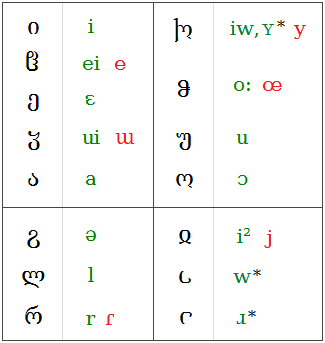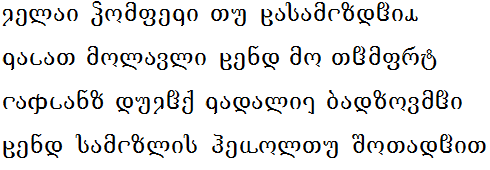It turns out that the phoneme inventory of SIGIL has much in common with Georgian, and since I like the Georgian script, I thought it might be nice to try and adapt that for the writing of SIGIL. Fourteen letters were borrowed from the “sister” script Hayeren (Armenian) to make it complete.
Consonants
The alphabet used here is that called Mxedruli. A mxedruli-style set of Armenian letters is used to represent extra sounds not found in Georgian (see below for the derivation of their forms). The phonemes with an asterisk * are given Armenian-based letters. The archaic Mxedruli letters he and qar are re-instated, and the supplementary letters fi, elifi, turned-gan and ain are also used. The phonemes in red are re-assignments, close enough to their original use that their choice is easily justified. Note how the Georgian postalveolars jan, chin, shin, zhan and ch’an are shifted back to the retroflex position.
Mxedruli has a lovely assortment of shapes which sit well together, and is so complete that no diacritics are required. The shapes are mostly not related phonologically, and this is a different strategy to my other SIGIL scripts; the strength of this (and it is common in old alphabets) is that distinctness of letters is emphasized.
Vowels and liquids
The archaic Mxedruli letters hie, we and hoe are re-instated, and the supplementary letter shva is also used. It was possible to use the diphthongs to suggest individual new vowels.
In order to include a tone system that didn’t involve diacritics, some tone letters were made that follow their vowels. Here is /ma/ with normal, high, rising, falling and low tone (tone contours approximately 33 55 35 53 and 11).
Armenian adaptations
The biggest challenge was making the Armenian letters somehow match the Mxedruli style. Below is my rendition of such a set, showing the original Hayeren in the first column. The je, cha, sha and zhe are palatalized with yi and made into ligatures. The phonemes for za and se have been moved forward to become dental fricatives. The vowel iw has been made into a single glyph and shaped to match Mxedruli on. The approximants hiwn and re lose their serifs. The velar continuant lat is conveniently similar to the IPA symbol. The upper-case of tsa and dza are used for dental affricates, and the upper-case of tsha and sha are used as lateral affricate and fricative.
Example
This is the beginning of Shakespeare’s sonnet 18 again (transliteration), for comparison with other versions of SIGIL etc. It uses six of the new Armenian-based letters.
“Shall I compare thee to a summer’s day?
Thou art more lovely and more temperate;
Rough winds do shake the darling buds of May,
And summer’s lease hath all too short a date;”
Georgian letters from font DejaVu Serif.






